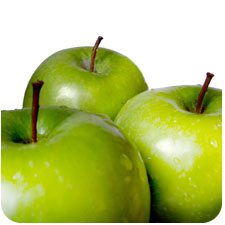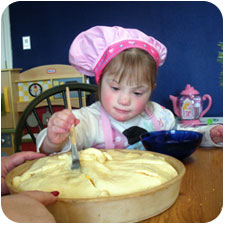
What to Feed Your Child with DS and Why
 There has been much discussion as to the nutritional needs of many children with many labels, particularly children with Down Syndrome. Children in the United States as well as in many other countries are consuming diets that are laden with simple carbohydrates and dairy products. Although adults are often aware of a diet that will best maintain their own health, often these principles are not applied to their children.
There has been much discussion as to the nutritional needs of many children with many labels, particularly children with Down Syndrome. Children in the United States as well as in many other countries are consuming diets that are laden with simple carbohydrates and dairy products. Although adults are often aware of a diet that will best maintain their own health, often these principles are not applied to their children.
Organic vegetables have many of the nutrients needed for the body to remain healthy and strong and for the brain to be active and alert. These nutrients are introduced in perfect forms to be digested and absorbed. Despite this, many children are being given very few of these. On the other hand, breads, sugars, pastas and most cereals contain simple carbohydrates known to grow yeast in the intestinal tract and result in confused thinking, slow digestion and constipation.
Digestive issues are common in children with Down Syndrome and can often be prevented by starting the child on a digestible diet and preventing or treating yeast and constipation issues as soon as they appear. Living with constipation is not a viable option as it allows toxins to leak into the gut through the small intestine. It is essential that parents of children with Down Syndrome be proactive in feeding their children diets rich in vegetables. Fruits can also assist in keeping the digestive system working well in some children. Issues such as pre-celiac conditions can also respond well to feeding only foods that are easily digested.
Foods should be healing and promote health. Eating should be a means of sustaining health. Purchase foods that are grown as opposed to manufactured. Purchase foods that are in their natural state as much as possible. Feed your child foods that are digestible such as goat dairy as opposed to cow dairy. Also feed your child foods that do not foster congestion.
If your child is experiencing reflux, learn which foods are acidic and which are alkaline. The alkaline foods will work best for your child. There is a list of these foods on the NACD website under Health and Nutrition.
If we were to invent good kids’ meals for your child with DS, they would include things such as spinach, parsley, kale and sweet potatoes, organic eggs, a small amount of organic meat and fruit, as well as some grains such as millet. They would include clean water as the perfect drink.
Instead of thinking in terms of giving your child a massive amount of supplements to try to fix absorption issues, try healing your child with these natural foods perfect in their nutritional content with the right combination of nutrients to enable absorption.
Food Sensitivities
Robert J. Doman, M.D.
 There are a number of behavioral and medical problems that may indicate food sensitivities in a child. The symptoms can include nose and throat congestion, headaches, and post nasal drip. Many foods and food product additives can result in food sensitivities. NACD recommends that parents consider an elimination type diet when this condition is suspected.
There are a number of behavioral and medical problems that may indicate food sensitivities in a child. The symptoms can include nose and throat congestion, headaches, and post nasal drip. Many foods and food product additives can result in food sensitivities. NACD recommends that parents consider an elimination type diet when this condition is suspected.
Food sensitivities can be quite variable. Certain foods frequently, but not always, cause problems. For example, eating a suspected food during the daytime when the child is active may cause little or no problem. However, the same food eaten before bedtime may lead to severe congestion through the night and the next morning. As a result, bedtime snacks, in particular, need to be avoided by children with food sensitivities.
Candida Albicans
Dr. Julian Neil
Birth control pills, all antibiotics, steroid drugs, and any drugs that suppress the immune system response or assist in the rapid reproduction and expansion of candida in the body are responsible for minute colonies of candida that expand like a vast army. They may start in the bowel or vaginal tract, then travel throughout the body.
Symptoms ranging from “feeling bad all over,” to allergy-like symptoms and symptoms mimicking those of hypothyroidism and hypoglycemia. Other symptoms include: abdominal discomfort, anxiety, arthritis pain, bloating, canker sores, colitis, constipation, coughs, depression, diarrhea, dizzy spells, enteritis, fatigue, food intolerance, headaches, heartburn, hiatial hernia, impotence, insomnia, irritability, joint pain, menstrual and sex problems including loss of interest, muscle pain, nasal congestion, numbness, pelvic pain, poor memory, premenstrual tension, prostatitis, environmental sensitivities, sinusitis, sterility, tingling, urinary infection, and vaginitis, among others.
Major sources in food are milk sugars and wheat products. The bacteria feeds on sugars, and yeast containing foods like bread, processed grains, cake, cheese, candy, soft drinks, beer, wine, syrup, honey, root beer, cider, ketchup, processed meats, canned or frozen fruit, and fruit juices—even fruits in general—smoked meats, dried fruits, coffee, tea, melons, buttermilk, sour cream, and all processed foods.
NACD 5492 S 500 E Washington Terrace, Utah 84405 | Phone: (801) 621-8606 Fax: (801) 621-8389
Copyright 1986–2017 The National Association for Child Development. All rights reserved.









